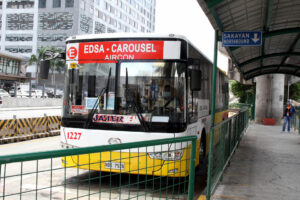By Arjay L. Balinbin, Senior Reporter
THE Management Association of the Philippines (MAP), an advocate of privatizing the bus system servicing Epifanio delos Santos Avenue (EDSA) as well as urban railways, said the utilities and infrastructure industries offer sufficient precedent for the private management of public goods.
MAP said privatization is the best way to improve the EDSA Busway, which suffers from long queues as demand overwhelms the available number of buses.
“Privatization of public utilities and infrastructure has many precedents,” MAP Infrastructure Committee Chair Eduardo H. Yap told BusinessWorld in an e-mail on Wednesday.
Mr. Yap wrote BusinessWorld in response to an article in which analysts raised questions over the proposed EDSA Busway privatization.
His organization recently urged the Department of Transportation (DoTr) to consider privatizing the EDSA Busway and bus service as well as commuter rail lines still largely in public hands like Metro Rail Transit Line 3 (MRT-3), Light Rail Transit Line 2 (LRT-2) and the Philippine National Railway (PNR) commuter lines.
“Privatization of public utilities and infrastructure has many precedents. LRT-1 was recently privatized, while MRT-7 is being developed and will be operated by a private concessionaire,” Mr. Yap said.
“These existing concession agreements may serve as models or guides for the privatization of the EDSA Busway,” he added.
He said that some of the concerns expressed by analysts are “considerations that are known and will be among matters to be discussed in a series of roundtable discussions with privatization experts and stakeholders.”
“The bottom line is that this busway on EDSA has proven to be more efficient than the previous bus transportation system on the yellow bus lanes. But it is a work in progress that must be quickly and properly completed in accordance with global standards and availing of the latest high-capacity commuter clean-energy buses,” he said.
“Privatization will realize this objective and optimize this busway to its fullest potential as a mass transit system without severe overcrowding and long wait for ride.”
High fares, underinsurance, government meddling that deters investment recovery, and unresolved issues with the implementing rules and regulations of the Build-Operate-Transfer (BOT) Law are among the concerns raised about any privatization exercise.
Business groups have criticized the new rules for the BOT Law, saying private proponents will shoulder more risk while the government is relieved of responsibility for delayed deliverables.
MAP is proposing a “hybrid” public-private partnership model, in which the government provides the infrastructure, while a private company operates the service and maintains the facilities under an operations and maintenance concession.
MAP has offered to work with the DoTr and other private sector parties in preparing the terms of reference for the bidding and award of the concessions “to ensure a level playing field for all.”
EDSA Busway upgrades recommended by MAP include increasing the capacity of station platforms to accommodate more commuters and enable simultaneous docking of buses, the construction of more stations near footbridges and concourses dedicated to the busway, expediting the construction of donated busway station footbridges, resolving chokepoints along the carousel line, replicating the busway in other major commuter corridors in the National Capital Region, and easing bus-to-train connectivity.
Other recommendations are to provide bus exchange stations for trunk-to-feeder line transfers, decongest the Ayala stations and McKinley Road by providing an alternate route between Bonifacio Global City and Buendia stations, and modern high-capacity bi-articulated electric commuter buses.
